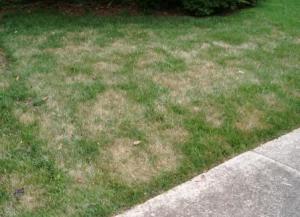How to ID Lawn Insect and Lawn Fungus Problems
How do you know if the brown spots in your lawn are caused by the heat (that you can’t do anything about) or something else (that you can do something about)?

Are the brown grass blades mixed in with the green grass blades in no particular pattern almost like the lawn is dry, yet you have been getting rainfall? This could be an insect problem or your lawn could be starving if it has been more than a few months since the last feeding. One clue to look for with insects is the presence of lawn moths when you mow. The moths do not damage your lawn, however they lay eggs for sod webworm, cutworm and other lawn damaging insects. Chinchbug damage also looks like the grass in this photo. Solution: Feed and protect your lawn with an application of Turf Builder with SummerGuard. Be sure to water after spreading. If your lawn does not need feeding, apply Ortho Bug B Gon MAX.

Are the brown spots following a particular pattern such as a circle? Within the circle the problem may start with some of the grass blades turning brown with spots on them. There are a range of lawn fungus problems like dollar spot, brown patch, red thread and summer patch that show up as circular patches in your lawn. These problems can crop up when you are getting higher temps during day and night and more rain and humidity. Solution: Treat your lawn with Scotts Lawn Fungus Control.

Do some areas of your lawn always seem to turn brown first? Probe the brown spot with a screwdriver and compare this with the healthy lawn areas. I have found that the typical brown, tan-colored “dry spot” can show up because of a pocket of poor soil, a buried rock that is just below the soil surface, or an area where lawn sprinklers don’t provide complete coverage making it tougher for the screwdriver to penetrate. So you think your lawn is getting adequate water, however this dry spot is the first area to go brown. Solution: Give extra water to this area until you are able to improve the soil in this spot, dig up buried rock or adjust sprinklers.

This is some excellent information on identifying lawn insects and fungus issues in the lawn. Thank you for the great information.
Hi sklawncare
Thanks for passing along this info on your blog!
How many steps do you now have, I use 1-4 steps as advertised however insects , brown spots, weeds of all kinds are all over. Please advise where Scotts shows how to dig out bad area and replace soil little at a time. I am older gent can only do so much
Hi Leonard Leone
Your 4 feedings are a good basic approach. Some locations also could benefit from an application of GrubEx in May or June. Some other locations could benefit from an additional insect control like Ortho Bug B Gon MAX in mid summer. Your Step 1 Crabgrass Prevention and your Step 2 Weed & Feed will get most of your weed problems, if applied at the right time. There are some other troublesome weeds that can be spot treated with Ortho Weed B Gon MAX. Depending on where you are located you could seed in early fall. Generally, you do not need to replace your existing soil. Let me know where you are located and I will give you some specific suggestions.
revere, ma .02151
Hi Leonard
Thanks for giving me your location. Suggested application schedule to provide 4 feedings a year and protection from Grubs and Insects: Mid April Turf Builder with Halts or Step 1, Mid May GrubEx, Late May Turf Builder Weed & Feed or Step 2, July Ortho Bug B Gon MAX, Late August Turf Builder or Step 3, Early October Turf Builder WinterGuard or Step 4. You can spray any stray weeds during the year with Ortho Weed B Gon MAX plus Crabgrass Killer. If you need to do any seeding, Early Sept is your best time. If you seed, do not spray any weed controls in that area for a month before, and until the new grass has been mowed 4 times. If you have an area where you want to kill everything and start over, you can spray with Roundup in mid August, spray again in 7 to 10 days if needed and then you can break up the soil and seed that area 7 days after your last spray. Starter Lawn Food would help your new seeds grow (you would not need any other lawn food). Hope this helps.
I have an orange, powdery “rust” in patches all over my lawn. The descriptions above do not reflect what I am seeing. What is it and How do I control it?
Hi Doug
Your lawn has a fungus called Rust. This problem is common in late summer and early fall. Feeding your lawn helps to minimize this disease. The good news is that it does not kill your grass, just turns your shoes and mower orange.
suggest Scotts put more info at home depot on what else to use during and after program steps 1-4 are being apply
Hi Leonard
Thanks for your suggestion. Lawns in areas of the country with longer growing seasons could benefit from a fifth feeding. So the schedule would be first feeding in March, with the other three in May, July and September. The fifth feeding with Turf Builder WinterGuard or WinterGuard Weed & Feed would go down about 6 weeks after the fourth feeding.